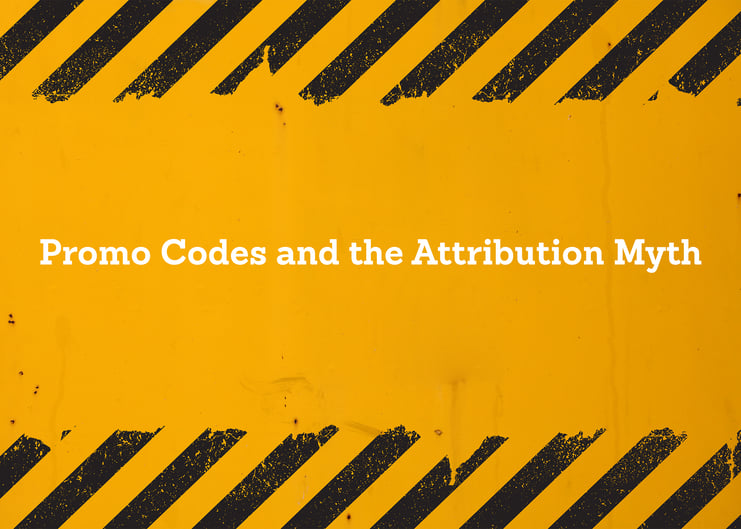Promo codes are wildly popular in driving additional demand for marketers, but PROCEED WITH CAUTION if your goal is to track conversions and measure the success of your promo code campaigns.
I think we can all picture our parents or grandparents reading the newspaper on Sunday morning, getting to the weekly circular section, grabbing a pair of scissors and cutting coupons. I would go as far as to say, as consumers, we’ve all used coupons, a voucher entitling the holder to a discount for a particular product, at one time or another. As more transactions occur online, coupons have undergone a transformation. An online coupon, more commonly referred to as promotional or “promo” code, is a code (a series of letters and numbers) offered by retailers to consumers who can use it to receive a discounted price when buying a product. When purchasing online, consumers will often see a field on the checkout page to enter a promo code and have that discount applied.
The use of promo codes by marketers is typically one component of their overall marketing strategy to drive additional demand. Offering a discount to a consumer gives them an additional reason to buy from you. Simply put, consumers love to save money. According to the marketing blog, Amasty:
- 60% of consumers love to receive digital coupons
- 68% of consumers state coupons generate loyalty and build brand awareness
- 50% of consumers are more likely to visit a store if they have received a coupon
And, according to MarketingProfs, 57% of US online shoppers who used a promo code said that if they had not received the discount, they would not have bought the item(s). Indoor Media reports that up to 80% of consumers are willing switch brands, experience a new brand, because of this discount offer.
In addition to the obvious benefit of driving new customer acquisition and ultimately incremental demand, the use of promo codes can provide marketers with a wealth of additional information. Promo codes are used to incentivize consumers to follow them online, to purchase through a specific channel, and to share additional elements of customer information. Many marketers will also use promo codes to track their marketing efforts and to measure the effectiveness of specific marketing campaigns. It is with this last use case that marketers can run into trouble if not careful.
Today’s consumer is everywhere. They are researching products online. They are visiting retail stores to touch and feel the product. They are visiting the website to get exposure to more inventory, more options. They are receiving emails and exposed to display advertising to keep the brand front of mind. They are being sent promo codes via email and display ads and through direct mail.
Consider this scenario.
You are in the market for a new TV. You visit the Best Buy website to do some research. When you get to the site, you are asked for your email address, so they can send a special offer just for you. You leave the website without transacting. Shortly after, you receive a display ad, to try and drive you back to the website. A promo code for 10% off, TVTAKE10, is in the display ad. You saw the ad for one second. No time to capture the code. Tomorrow you receive an email with a promo code MEMBER19, for 10% off. This was one of a hundred emails you received. You don’t even open it. Two days later, you receive a postcard at your home, with an offer you can touch and feel like the old days of using a coupon. In the bottom corner, there is a promo code HOLMAIL19.
You go to the closest retail location and experience the product live. You go home, consider the purchase and decide to buy. You go back to the website, put the TV in the cart, go to the checkout page and see the field for the promo code. You never did capture that code in the display ad. You can’t find that email anymore; you deleted it. That postcard is buried in the recycle bin. So, you search online for any promo code, can’t find one that works and check out, leaving that field blank.
Which marketing channel gets credit for the sale? Do any of them?
While promo codes may be instrumental in driving brand awareness and encouraging a consumer to take action, not all consumers will use the promo code offered when transacting – but it doesn’t mean the offer didn’t influence that transaction.
The best way to determine if a marketing campaign influenced a transaction is to do a matchback analysis after the fact. You must be disciplined in how you set up your marketing campaigns to ensure a control panel in which to compare to. Which consumers received which campaigns? Which consumers did not? What was the conversion rate – how many people actually transacted - from each of the exposed groups in comparison to the unexposed groups?
Without doing this type of analysis, if relying solely on the use of promo codes when not all consumers will use a promo code or they receive multiple promo codes with the same offer, you will not get a completely accurate read on a marketing programs effectiveness.

Lookalike Audiences Enhance customer acquisition by identifying high-potential prospects, boosting response rates, and lowering advertising costs.
Retargeting Postcards Double the performance of your direct mail retargeting.
Amplify Recognize unknown visitors who are actually customers. Add 20-40% to your ESP/CRM campaigns.
IQ Mail Retain customers with personalized, timely messages for those opting out of digital channels.




.png?width=450&height=250&name=Blog%20Image%20(3).png)
Comments